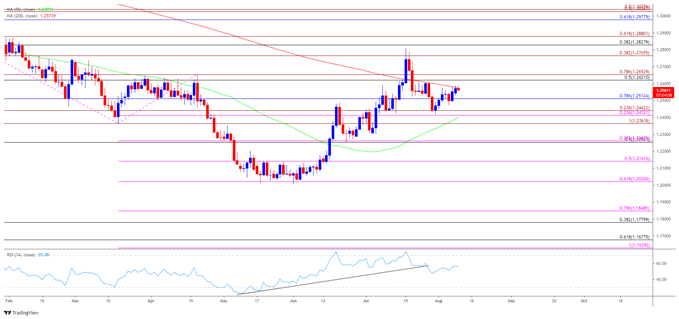Canadian Dollar Talking Points
USD/CAD struggles to hold above the 200-Day SMA (1.2399) even as a growing number of Federal Reserve officials show a greater willingness to switch gears, and the update to the US Consumer Price Index (CPI) may undermine the recent advance in the exchange rate as inflation is expected to slow down for the first time in 2021.
USD/CAD Post-NFP Rally Vulnerable to Slowdown in US CPI
USD/CAD carves a series of higher highs and lows following the US Non-Farm Payrolls (NFP) report as the ongoing improvement in the labor market puts pressure on the Federal Open Market Committee (FOMC) to scale back its emergency measures, but the updated CPI figures may produce headwinds for the US Dollar as the headline reading is expected to narrow to 5.3% from 5.4% in June.
The core CPI is anticipated to show a similar dynamic as the figure is projected to print at 4.3% in July versus 4.5% the month prior, and signs of transitory inflation may encourage the FOMC to retain the current course for monetary policy as Governor Lael Brainard expects “to be more confident in assessing the rate of progress once we have data in hand for September.”
However, Boston Fed President Eric Rosengren, a FOMC voting-member in 2022, insists that the central bank could start to winding down its emergency measures “this fall” during an interview with the Associated Press, with official going onto say that “I don’t think asset purchases are having the desired impact on really promoting employment.”
Speculation for a looming shift in Fed policy may keep USD/CAD afloat as the Bank of Canada (BoC) “now expects GDP growth of around 6 percent in 2021 – a little slower than was expected in April,” and a further appreciation in the exchange rate may alleviate the recent shift in retail sentiment like the behavior seen earlier this year.
The IG Client Sentiment report shows 65.48% of traders are currently net-long USD/CAD, with the ratio of traders long to short standing at 1.90 to 1.
The number of traders net-long is 7.48% higher than yesterday and 8.72% lower from last week, while the number of traders net-short is 3.23% higher than yesterday and 1.13% higher from last week. The decline in net-long position comes as USD/CAD struggles to hold above the 200-Day SMA (1.2399), while the rise in net-short interest has helped to alleviate the crowding behavior as 69.82% of traders were net-long the pair last week.
With that said, a further advance in USD/CAD may alleviate the recent shift in retail sentiment like the behavior seen earlier this year, but the update to the US Consumer Price Index (CPI) may undermine the recent advance in the exchange rate as inflation is expected to slow down for the first time in 2021.
USD/CAD Rate Daily Chart
Source: Trading View
- Keep in mind, the 200-Day SMA (1.2574) for USD/CAD continues to reflect a negative slope, with the exchange rate failing to hold above the moving average in July as the advance from the yearly low (1.2007) fails to spur a test of the January high (1.2881).
- Recent developments in the Relative Strength Index (RSI) indicates a similar dynamic as it snaps the upward trend from earlier this year after flashing a textbook sell signal last month, and the decline from the July high (1.2808) may mark the resumption of the broader trend as a bearish formation appears to be taking shape in the RSI.
- In turn, USD/CAD may trade within a defined range as it appears to be capped by 1.2620 (50% retracement) to 1.2650 (78.6% expansion) region, and lack of momentum to hold above the 200-Day SMA (1.2574) may push the exchange rate back towards the 1.2510 (78.6% retracement) area, with the next area of interest coming in around 1.2410 (23.6% expansion) to 1.2440 (23.6% expansion).
- Need a break/close above 1.2620 (50% retracement) to 1.2650 (78.6% expansion) to open up the 1.2980 (61.8% retracement) region, with the next area of interest coming in around 1.3030 (50% expansion) to 1.3040 (50% expansion).
— Written by David Song, Currency Strategist
Follow me on Twitter at @DavidJSong




Be the first to comment